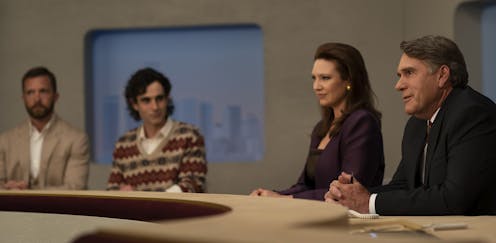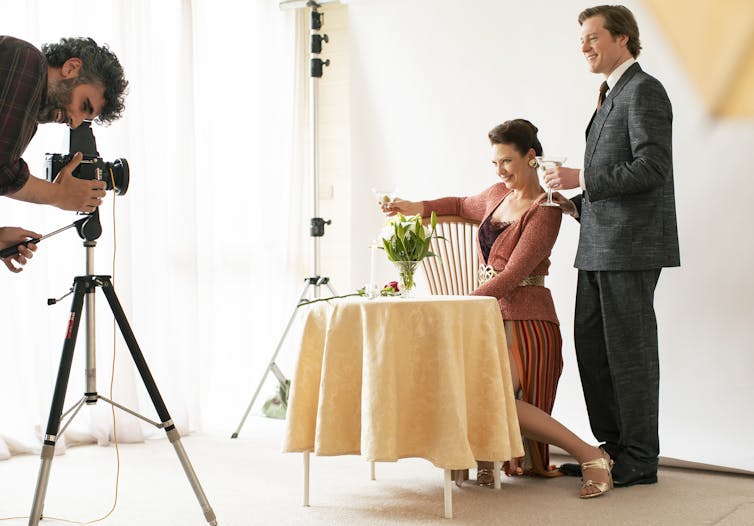Source: The Conversation (Au and NZ) – By Helen Vatsikopoulos, Lecturer in Journalism, University of Technology Sydney

ABC Publicity
Review: The Newsreader, ABC TV
1986 was a very big news year: history-making moments captured by television. The Space Shuttle Challenger exploded live on air. Who can forget the camera lingering on the horrified faces of Christa McAuliffe’s parents, the teacher-in-space being incinerated before our eyes.
Chernobyl’s number 4 reactor gave us the world’s worst nuclear disaster. In Melbourne, a car bomb at the Russell Street Police Headquarters extinguished the life of Angela Taylor, the first policewoman to be killed in the line of duty.
This is the era explored in the ABC’s new TV drama The Newsreader. Creator Michael Lucas and director Emma Freeman have made a program so accurate it gave me a jolting sense of déjà vu.
In 1986, I had just left behind the “slow-news-day” world of Adelaide, packing up my power suit and transferring to the ABC newsroom in the Melbourne suburb of Elsternwick. It was the big smoke with bigger stories, and it was getting faster.
In Adelaide we might have replaced film with tape but we still typed on heavy, steel, manual typewriters and carbon copy paper. My first day was terrifying as I grappled with a huge, speedy electric typewriter.
Read more:
Why do we find it so hard to move on from the 80s?
The Newsreader captures the changing nature of news-gathering. Stories came via telex, fax and AAP wire. Chiefs of staff eavesdropped on police scanners, communicating with crews on two-way car radios. And there was good old-fashioned “shoe leather reporting”: journalists walking out of the office, observing, meeting people and cultivating contacts.
News at Six, the fictional news program in the ABC series, depicts a typical commercial newsroom of the time. This was the golden age of TV when the rivers of advertising gold flowed freely and ratings made, or broke, careers. A reporter was only as good as their last story but if you delivered enough scoops you too could aspire to become a newsreader, a celebrity and a trusted public figure.
Exaggeration and ambition
In the series, Lindsay Cunningham (William McInnes) is the bullying, sexist news director playing staff off against each other with the promise of a career as a newsreader.
“Newsreading is the duck’s nuts,” he tells rookie reporter Dale Jennings (Sam Reid), “.. great pay and you get to waltz in here at midday.”
Except that the news cycle is starting to get faster — news breaks, which can interrupt the programming schedule at any time of day, have increased the pressure to be the first network with breaking news and updates.
Enter Helen Norville (Anna Torv) clever, very ambitious and highly telegenic. Helen (as I did) has big helmet hair, big earrings and even bigger shoulder pads. It was as if exaggeration could make us more visible.

ABC Publicity
Helen is an anchor woman in the new double header line up. Her co-host, veteran newsman Geoff Walters (Robert Taylor) has already sensed serious news is under threat. A former Vietnam War correspondent, Geoff has the “big G for Gravitas” in spades, but unfortunately that is no longer enough. Helen has the “big G for Glamour” and audiences now want eye candy with their bulletin.
How sexist was it back then? Men were in the majority and the decision makers, but women were moving in and up. ABC journalist Mary Delahunty won a Gold Walkley in 1983. Nine’s Jana Wendt conquered 60 minutes, and went on to A Current Affair where she became known as “the perfumed steamroller”, eventually winniing the Gold Logie.
I have never worked in commercial television. Still, it was common knowledge that female reporters were often judged on their “f…ability quotient”. In one episode of the show, Lindsay arrives at Helen’s house ostensibly to discuss her career. He manspreads on her couch in a very uncomfortable scene until she is saved by the doorbell.
Read more:
TV presenters, sexism and the attractiveness double standard
Helen is brilliant but highly strung; while her work days are fuelled by adrenalin she’ll crash and burn in tormented private moments. When Dale rescues her from one of these episodes they become partners in the pursuit of a breaking story.
When Lindy Chamberlain is released from jail in episode three of the series, we get a snapshot of the lengths ambitious reporters will go for an exclusive: stake outs, trespassing and chequebook journalism. Helen and Dale have no ethical problem with offering a quarter of a million dollars for an interview but Geoff’s outrage is such that he sabotages his own network by leaking the offer to rivals at Channel Nine.
In real life, Ray Martin got that interview with Chamberlain and 60 minutes (along with The Women’s Weekly) paid up.
Competition
There are some great characters in The Newsreader and episodes of note. Noelene (Michelle Lim Davidson) is the smart and deserving production assistant who will never get a promotion. So good is she at her job, and making others look better, she has made herself indispensable.
(There is a hilarious scene where Dale is on the road and needs a fact checked. Noelene rummages through the files of newspaper clippings; Google now does this in an instant.)
Newsgathering in the 1980s was fuelled by adrenaline, competition, caffeine, cigarettes and alcohol. Yes, we drank and smoked in the newsroom. Competition was fierce.
A friend and colleague once diverted a crew away from me so he would have the exclusive. Crews were often in short supply and we all knew — no pictures, no story. Our intellectual property resided in our carefully cultivated and recorded contact books — mine was stolen from my desk sometime in ’86-87. We were motivated by bearing witness and we were trusted by the audience.
The Newsreader is a great piece of television drama but one thing doesn’t ring true. Commercial newsrooms in 1986 were not as diverse as the program pretends and definitely not so Asian.
Yes the ABC had journalist Prakash Mirchandani and fourth-generation Chinese Australian Helene Chung was the ABC’s Beijing correspondent. But they were working for the public broadcaster and they were one offs. Some things take a long time to change.
The Newsreader airs on ABC TV on Sundays at 8.30pm, or is available to watch on iview.
![]()
Helen Vatsikopoulos is affiliated with ABC Alumni
– ref. Sexism, big hair, contact books: The Newsreader gets a lot right about 80s TV journalism but the times were not so diverse – https://theconversation.com/sexism-big-hair-contact-books-the-newsreader-gets-a-lot-right-about-80s-tv-journalism-but-the-times-were-not-so-diverse-165876







